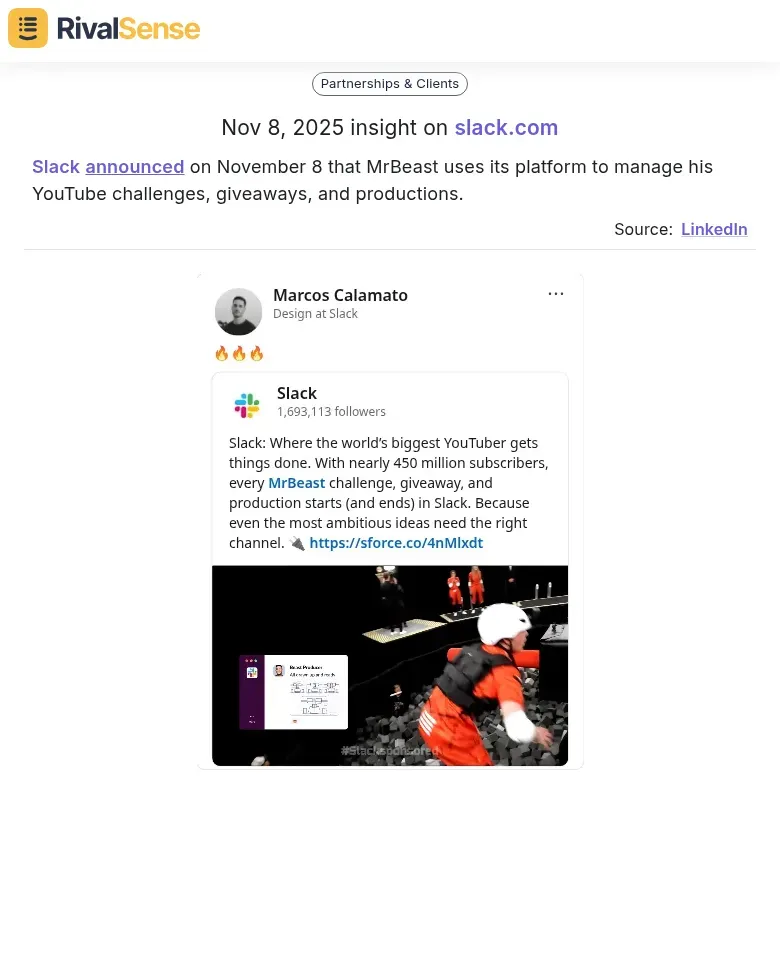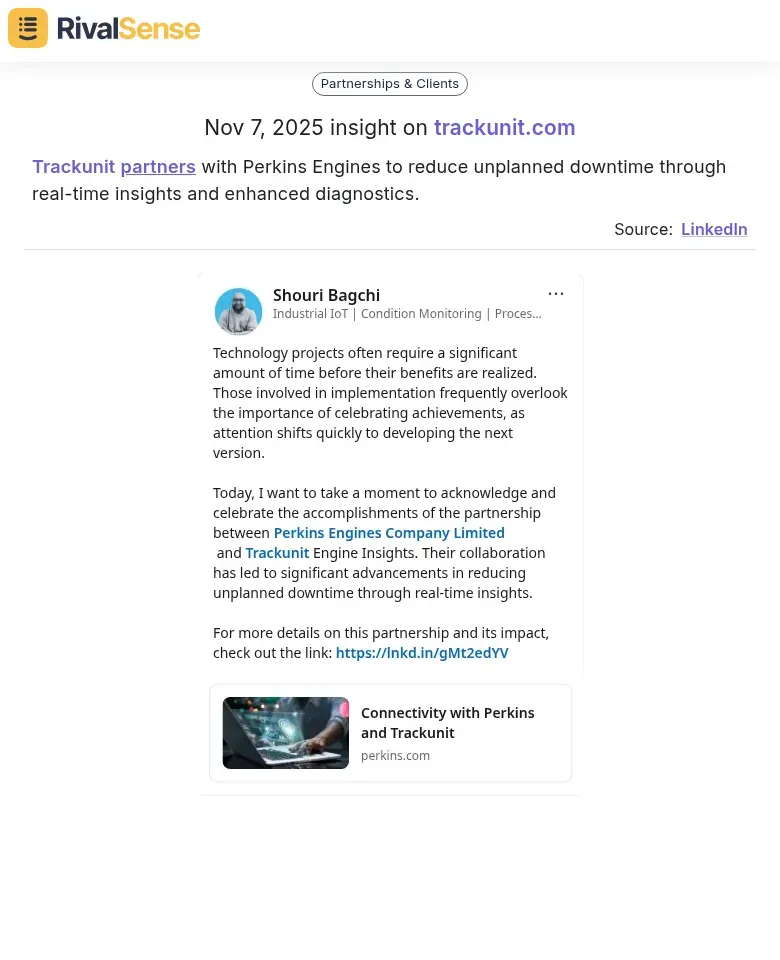Unlocking Growth Through Competitive Partnership Intelligence
Competitive partnership intelligence is the strategic practice of monitoring and analyzing your competitors' partnerships to uncover growth opportunities and market trends. By tracking who your rivals are collaborating with—whether through technology integrations, co-marketing campaigns, or joint ventures—you gain insights into emerging market needs, untapped customer segments, and potential partnership gaps you can exploit. This intelligence shifts your strategy from reactive to proactive, allowing you to anticipate market moves and align your own partnerships for maximum impact.
Practical Steps to Get Started:
- Identify top competitors and regularly review their partnership announcements on websites, press releases, and social media.
- Use tools like RivalSense to automate tracking and receive alerts on new competitor collaborations.
- Analyze the strategic intent behind each partnership—are they expanding into new markets, enhancing product offerings, or targeting specific customer segments?
- ✅ Create a checklist: document partnership types, key players, timelines, and perceived outcomes to spot patterns over time.
By leveraging these insights, you can forge smarter alliances, avoid competitive threats, and drive sustainable growth through informed decision-making.
Learning from Competitor Collaborations: Key Insights and Patterns
Analyzing competitor partnerships reveals powerful growth strategies and uncovers emerging trends that can inform your own business decisions. By understanding who your rivals are teaming up with, you can anticipate market shifts and identify collaboration opportunities that align with your goals.
Real-World Insight: Slack announced on November 8 that MrBeast uses its platform to manage his YouTube challenges, giveaways, and productions. This type of insight is valuable as it demonstrates how partnerships with high-profile influencers can enhance brand visibility, operational efficiency, and access to new audiences.

Cross-industry alliances like Uber-Spotify show how partnerships expand market reach by accessing each other's customer bases. To apply this: identify non-competing companies with shared audiences and propose mutual value exchanges.
Tech integrations and co-development drive innovation. For instance, Apple Pay's early partnership with MasterCard positioned both as forward-thinking leaders. Track competitors' API integrations and joint R&D announcements to spot emerging trends.
Checklist for Monitoring Collaborations:
- ✅ Monitor tech blogs, patent filings, and partnership announcements monthly.
- ✅ Document partnership types, key players, timelines, and outcomes to identify patterns.
- ✅ Evaluate how complementary services (e.g., Starbucks in Target stores) can enhance product value and customer experience.
Case Study Insights: General Takeaways from Real-World Examples
Real-world competitive partnership intelligence reveals powerful growth strategies that can transform businesses and drive measurable results. Case studies illustrate how leveraging partnerships improves operational efficiency, reduces costs, and enhances credibility in the market.
Recent Example: Microsoft signed the first AI collaboration agreement with the Buenos Aires Public Ministry to transform the public sector in Latin America. This insight is valuable as it shows how partnerships with government entities can open new markets, build trust, and position companies as innovators in emerging sectors.

For instance, a tech firm collaborating with a diagnostics provider for real-time data sharing cut operational expenses by 30% and streamlined workflows. To replicate this, conduct a cost-benefit analysis of potential partners, identify shared goals, and establish clear communication protocols.
Gaining credibility and trust is another key takeaway. By associating with reputable entities, companies enhance their brand perception. A startup partnering with a well-known government agency saw a 40% increase in customer trust scores.
Tips for Building Credibility:
- Vet partners for alignment with your values and mission.
- Co-brand initiatives and showcase endorsements in marketing materials.
- Use partnerships to navigate regulatory hurdles and accelerate market entry, as seen in cases where companies achieved 50% faster expansion.
Implementing Partnership Intelligence in Your Strategy
To implement partnership intelligence effectively, start by leveraging tools like RivalSense to track competitor alliances, joint ventures, and co-marketing efforts. Use methods such as monitoring press releases, social media announcements, and partnership pages on competitor websites to gather actionable data.
Insight Example: Trackunit partners with Perkins Engines to reduce unplanned downtime through real-time insights and enhanced diagnostics. This type of insight is valuable as it highlights how strategic partnerships can improve product offerings, increase customer satisfaction, and drive operational efficiencies by addressing specific pain points.

Integrate these insights into your SWOT analysis by identifying opportunities (e.g., gaps in competitor partnerships) and threats (e.g., strong alliances blocking market entry). In strategic planning, use this data to prioritize partnership targets that align with your growth goals.
Best Practices Checklist:
- ✅ Act swiftly on intelligence: evaluate potential partners based on complementary strengths, shared audiences, and mutual benefits.
- ✅ Regularly review and update your partnership strategy to stay agile and capitalize on emerging opportunities.
- ✅ If a competitor partners with a tech firm, consider alliances with alternative providers to counter their move and maintain competitiveness.
Measuring the Impact: KPIs for Partnership-Driven Growth
To effectively measure partnership-driven growth, it's crucial to track key performance indicators that reflect the success of your collaborations. By monitoring these metrics, you can assess ROI, optimize strategies, and ensure long-term competitive advantage. Track KPIs such as Market Share (percentage gained through partners), Customer Acquisition Cost (CAC) reduction via partner channels, and Partner-Sourced Revenue.
For ROI assessment, calculate: (Revenue from partnerships - Intelligence costs) / Intelligence costs. If ROI is low, optimize by refining partner selection criteria or intelligence tools.
Practical Steps for Measurement:
- ✅ Use a dashboard to monitor KPIs monthly and conduct quarterly ROI reviews.
- ✅ Adjust strategies based on data trends and foster partner feedback loops for continuous improvement.
- ✅ Long-term, this approach enhances innovation by identifying collaborative R&D opportunities and building sustained competitive advantage.
Conclusion: Future-Proofing Your Business with Ongoing Intelligence
In today's dynamic markets, continuous partnership monitoring is no longer optional—it's essential for agility, growth, and staying ahead of competitors. By systematically tracking competitor alliances, you can anticipate market shifts, identify collaboration opportunities, and mitigate risks before they impact your business.
Adopt a structured approach: use tools like RivalSense to automate tracking, set up alerts for key partnership announcements, and regularly review insights with your team. Transform these findings into actionable strategies by integrating them into quarterly planning sessions, adjusting your outreach based on competitor gaps, and exploring co-marketing with aligned partners.
Actionable Tips for Implementation:
- ✅ Start small with a weekly check-in and build a partnership dashboard to visualize insights.
- ✅ Prioritize high-impact alliances and make competitive intelligence a core habit for sustained growth.
- ✅ Remember, the goal isn't just to gather data but to act on it—whether pivoting your product roadmap or seizing untapped markets.
Ready to turn competitive insights into your advantage? Try RivalSense for free at https://rivalsense.co/ and get your first competitor report today to start leveraging partnership intelligence for your business growth!
📚 Read more
👉 Leveraging Competitor Event Participation for Strategic Insights
👉 How to Track Competitor Podcasts for Market Dominance in Heavy Equipment Repair
👉 How RingCentral's AI Shift Reveals Your Next Growth Move
👉 Uncover Competitor Strategy Through Website Change Intelligence
